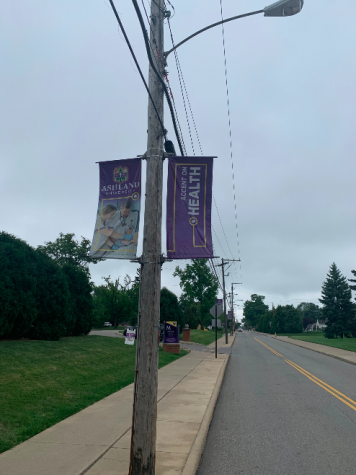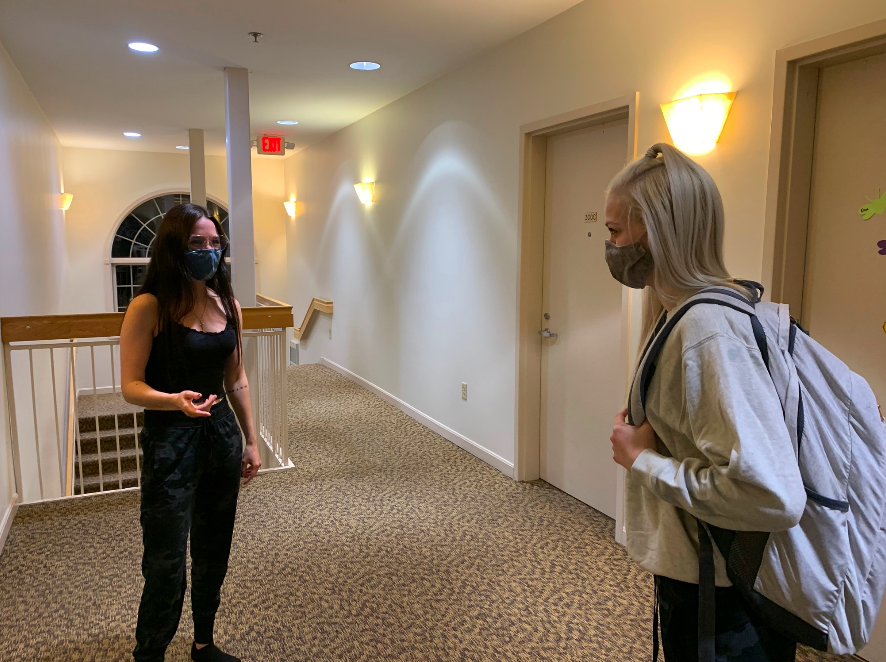The negative toll of COVID-19 and social isolation
AU students are required to wear masks whenever they are outside their place of residence.
September 18, 2020
Nobody could have predicted the state that the world is in today.
For Ashland University students, it began back in early March after receiving the news that all classes would be held virtually for the remainder of the semester and that students were to promptly move out of on-campus housing.
What began as a normal spring semester had spiraled into one consumed with zoom calls, social isolation and seeing too many people post about making banana bread on Instagram.
In the following weeks, the mandatory quarantine was put in place and the effects of isolation were beginning to set in.
Some people handled it well by staying productive, finding a new hobby or enjoying the time they had with their family, while others struggled with the isolation.
Everyone’s quarantine experience was different, but talking to multiple AU students showed that one of the biggest tolls it took on individuals was the feeling of social isolation and loneliness.
Senior Kassidy Lambert lives with her boyfriend whose job was deemed essential, meaning she was left alone for the majority of the day with just her cat to keep her company.
“I was alone all day until around 7 p.m. every night,” she said. “I just had myself and my cat and I hated it. Mentally it was terrible. I don’t like being by myself so that was hard.”
Lambert wasn’t the only one feeling the effects of being alone.
Senior Aggie Loucks also felt the negative effects of being socially isolated and struggled both mentally and physically.
“Mentally I was pretty depressed because I’m very social, so not being able to be around my friends and just people in general, outside of a couple family members, you kind of just have too much time on your hands,” she said. “Physically I lost a decent amount of weight because I stopped going to the gym and I wasn’t as hungry anymore because I was just sitting inside doing nothing all day.”
After coming to terms with the reality of quarantine and being isolated from people outside of their households, both Lambert and Loucks tried to find things that would take their minds off the unfortunate situation.
“I felt like I always needed to be doing something or I wasn’t being productive,” Lambert said. “I had to be cleaning or cooking or finding something new to do. I tried to find new hobbies. It didn’t work out for me but I tried baking a lot. I failed at the bread and I know everyone was doing the bread.”
In Loucks’ case, she found that watching intense movies or TV shows that portrayed fictional worlds in a worse state than our current world was comforting in a way.
“I know that sounds weird, but then you sit there and think ‘oh I could have it way worse’,” she said.
While some were negatively impacted by the guidelines of quarantine, others did not quite feel the same level of negativity.
“Personally, it wasn’t really different for me cause I don’t really go out much,” said junior Kam McQuillen. “The only difference is that it made work harder for me because I worked over the quarantine. Playing video games is pretty normal for me so it didn’t really affect me but I know it affected a lot of my friends.”
Due to the uncommon circumstances surrounding the virus, quarantine and social isolation, one of the topics being brought to the forefront of conversation was the impact it was having on mental health.
The CDC published survey data that was collected from individuals around the country to monitor recent changes in mental health due to the pandemic.
The 20 minute online survey included questions to obtain information on the frequency of anxiety and depression symptoms in the week prior.
The findings show that the 18-29 year-old age group had the highest percentages of either anxiety or depressive disorder from late April until late August.
College students fall directly in this age group, which raises the question of how universities around the country are prepared to help students and their mental health upon their return to campus.
“The isolation did make [mental health struggles] more presentable for people and made it more clear that it can really impact anybody,” said McQuillen.
Shannon Kahle, one of AU’s professional counselors, urges those who are struggling to reach out to someone or find an outlet that helps minimize those negative feelings.

“If you’re struggling and you want to talk to someone, you can contact the counseling center and talk to a counselor but there are other things you can do as well,” she said. “Do something that feels meaningful to you and helps you feel connected whether that’s taking on a project or volunteering or writing or listening to music — all those things that feel good and are nourishing to you.”
It can be difficult to see anything beyond the negativity of the present, but Kahle assures students to remain hopeful and avoid getting overwhelmed with the persistent news cycle.
“I would remind people that there is a light at the end of the tunnel, even though it might not feel like it,” she said. “This is temporary and there will be an end to this COVID isolation period and it will not be forever. Keep active, stay busy, keep yourself informed about what’s really going on with the virus and the vaccination, but don’t overdo it.”
In addition to AU’s counseling services, the Campus Wellness program offers various services to help students and staff create healthy and balanced lifestyles.
They encourage seven dimensions of wellness for optimal well-being that include emotional, physical, social, environmental, occupational, spiritual and intellectual wellness.
Dr. Deborah Sullivan, director of Campus Wellness, encourages students to find what works best for them and support others that may be struggling.

“Find what works for you,” she said. “If the [Ashland Healthy Mind] app works, use it. If the text-line works, use it. If talking to your RA works, do it. Even talking to a friend or a professional on campus.”
Sullivan ultimately hopes that with kindness, patience and understanding, students will begin seeing positive changes.
“I have great hope that we can provide that supportive environment. Just being patient with each other and being kind is the best way to help all of us because none of us know what we’re dealing with,” she said. “So I think if we all have that mindset of, I’m gonna do the best I can and support other people, we will get through this.”


